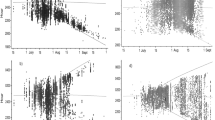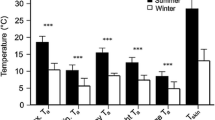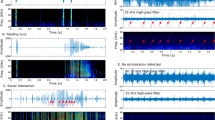Abstract
We used ultrasonic telemetry to examine movement patterns of 11 bat rays, Myliobatis californica, in Tomales Bay, California. Tomales Bay is long (20 km) and narrow (1.4 km), and is hydrographically separated into outer and inner bay regions. The outer bay (the outermost 8 km) is characterized by oceanic conditions while the shallow inner bay (the innermost 12 km) features wide seasonal temperature shifts. Five rays were tracked monthly from October 1990 to November 1991 and six rays (four of which carried temperature-sensing transmitters) were tracked daily from 30 June to 16 July 1992. Mean bat ray movement rate was 8.84 m min−1 (range 4.49 to 13.40 m min−1) and was not significantly affected by size (p=0.592), tidal stage (p=0.610), or time of day (p=0.327). Movement direction was unrelated to tidal stage (p=0.472) but showed a highly significant diel pattern (p<0.001). From 2:50–14:50 h, rays moved toward the warmer and shallower inner bay, while from 14:50–2:50 h they moved toward the cooler and deeper outer bay. These telemetry data, along with known bat ray foraging patterns and respiratory temperature-sensitivity, argue for behavioral thermoregulation as the primary influence on this movement pattern.
Similar content being viewed by others
References cited
Ackerman, J.T., M.C. Kondratieff, S.A. Matern & J.J. Cech, Jr. 2000. Tidal influence on spatial dynamics of leopard sharks, Triakis semifasciata, in Tomales Bay, California. Env. Biol. Fish. (in press).
Beitinger, T.L. & L.C. Fitzpatrick. 1979. Physiological and ecological correlates of preferred temperature in fish. Amer. Zool. 19: 319–329.
Bevelhimer, M.S. 1996. Relative importance of temperature, food, and physical structure to habitat choice by smallmouth bass in laboratory experiments. Trans. Amer. Fish. Soc. 125: 274–283.
Beyer, J.M., G. Lucchetti & G. Gray. 1988. Digestive tract evacuation in northern squawfish (Ptychocheilus oregonensis). Can. J. Fish. Aquat. Sci. 45: 548–553.
Biro, P.A. 1998. Staying cool: behavioral thermoregulation during summer by young-of-year brook trout in a lake. Trans. Amer. Fish. Soc. 127: 212–222.
Brett, J.R. 1971. Energetic responses of salmon to temperature. A study of some thermal relations in the physiology and freshwater ecology of sockeye salmon (Oncorhynchus nerka). Amer. Zool. 11: 99–113.
Carey, F.G. & J.V. Scharold. 1990. Movements of blue sharks (Prionace glauca) in depth and course. Mar. Biol. 106: 329–342.
Casterlin, M.E. & W.W. Reynolds. 1979. Shark thermoregulation. Comp. Biochem. Physiol. 3: 451–453.
Cortes, E. & S.H. Gruber. 1992. Gastric evacuation in the young lemon shark, Negaprion brevirostris, under field conditions. Env. Biol. Fish. 35: 205–212.
Fauconneau, B., G. Choubert, D. Blanc, J. Breque & P. Luquet. 1983. Influence of environmental temperature on flow rate of foodstuffs through the gastrointestinal tract of rainbow trout. Aquaculture 34: 1–2.
Gray, A.E., T.J. Mulligan & R.W. Hannah. 1997. Food habits, occurrence, and population structure of the bat ray, Myliobatis californica, in Humboldt Bay, California. Env. Biol. Fish. 49: 227–238.
Gruber, S.H., D.R. Nelson & J.F. Morrissey. 1988. Patterns of activity and space utilization of lemon sharks, Negaprion brevirostris, in a shallow Bahamian lagoon. Bull. Mar. Sci. 43: 61–76.
Holland, K.N., C.G. Lowe, J.D. Peterson & A. Gill. 1992. Tracking coastal sharks with small boats: hammerhead shark pups as a case study. Aust. J. Mar. Freshwater Res. 43: 61–66.
Holts, D.B. & D.W. Bedford. 1993. Horizontal and vertical movements of the shortfin mako shark, Isurus oxyrinchus, in the Southern California Bight. Aust. J. Mar. Freshwater Res. 44: 901–909.
Hopkins, T.E. 1993. The physiological ecology of bat rays Myliobatis californica in Tomales Bay, California. Ph.D. Dissertation, University of California, Davis. 104 pp.
Hopkins, T.E. & J.J. Cech, Jr. 1994. Effect of temperature on oxygen consumption of the bat ray, Myliobatis californica (Chondrichthyes, Myliobatidae). Copeia 1994: 529–532.
Huish, M.T. & C. Benedict. 1978. Sonic tracking of dusky sharks in the Cape Fear River, North Carolina. J. Elisha Mitchell Scien. Soc. 93: 21–26.
Karl, S. & S. Obrebski. 1976. The feeding biology of the bat ray, Myliobatis californica in Tomales Bay, California. pp. 181–186 In: C.A. Simenstad & S.J. Lipovsky (ed.) Fish Food Habits Studies, 1st Pacific Northwest Technical Workshop, Washington Sea Grant, Division of Marine Resources, Astoria.
Klimley, A.P., S.B. Butler, D.R. Nelson & A.T. Stull. 1988. Diel movements of scalloped hammerhead sharks, Sphyrna lewini Griffith & Smith, to and from a seamount in the Gulf of California. J. Fish Biol. 33: 751–761.
Klimley, A.P. & D.R. Nelson. 1984. Diel movement patterns of the scalloped hammerhead shark (Sphyrna lewini) in relation to El Bajo Espiritu Santo: a refuging central-position social system. Behav. Ecol. Sociobiol. 15: 45–54.
McKibben, J.N. & D.R. Nelson. 1986. Patterns of movement and grouping of gray reef sharks, Carcharhinus amblyrhynchos, at Enewetak, Marshall Islands. Bull. Mar. Sci. 38: 89–110.
McLaren, I.A. 1963. Effects of temperature on growth of zooplankton, and the adaptive value of vertical migration. J. Fish. Res. Board Can. 20: 685–727.
Medved, R.J. & J.A. Marshall. 1983. Short-term movements of young sandbar sharks, Carcharhinus plumbeus (Pisces, Carcharhinidae). Bull. Mar. Sci. 33: 87–93.
Miller, D.J. & R.N. Lea. 1972. Guide to the coastal marine fishes of California. Calif. Dept. Fish. Game Fish Bull. 157. 235 pp.
Montgomery, J. & E. Skipworth. 1997. Detection of weak water jets by the short-tailed stingray Dasyatis brevicaudata (Pisces: Dasyatidae). Copeia 1997: 881–883.
Neill, W.H. 1979. Mechanisms of fish distribution in heterothermal environments. Amer. Zool. 19: 305–317.
Neill, W.H. & J.J. Magnuson. 1974. Distributional ecology and behavioral thermoregulation of fishes in relation to heated effluent from a power plant at Lake Monona, Wisconsin. Trans. Amer. Fish. Soc. 103: 663–710.
Nelson, D.R., J.N. McKibben, W.R. Strong, Jr., C.G. Lowe, J.A. Sisneros, D.M. Schroeder & R.J. Lavenberg. 1997. An acoustic tracking of a megamouth shark, Megachasma pelagios: a crepuscular vertical migrator. Env. Biol. Fish. 49: 389–399.
Neverman, D. & W.A. Wurtsbaugh. 1994. The thermoregulatory function of diel vertical migration for a juvenile fish, Cottus extensus. Oecologia 98: 247–256.
Parrish, D.L. & F.J. Margraf. 1990. Gastric evacuation rates of white perch, Morone americana, determined from laboratory and field data. Env. Biol. Fish. 29: 155–158.
Ridge, R.M. 1963. Food habits of the bat ray, Myliobatis californica, from Tomales Bay, California. M.A. Thesis, University of California, Berkeley. 56 pp.
Sciarrotta, T.C. & D.R. Nelson. 1977. Diel behavior of the blue shark, Prionace glauca, near Santa Catalina Island, California. U.S. Fish. Bull. 75: 519–528.
Smith, J.W. & J.V. Merriner. 1985. Food habits and feeding behavior of the cownose ray, Rhinoptera bonasus, in lower Chesapeake Bay. Estuaries 8: 305–310.
Smith, S.V., J.T. Hollibaugh, S.J. Dollar & S.Vink. 1991. Tomales Bay metabolism: C-N-P stoichiometry and ecosystem heterotrophy at the land-sea interface. Est. Coast. Shelf Sci. 33: 223–257.
Sokal, R.R. & F.J. Rohlf 1995. Biometry: the principles and practice of statistics in biological research. W.H. Freeman and Co., New York. 887 pp.
Standora, E.A. & D.R. Nelson. 1977. A telemetric study of the behavior of free-swimming Pacific angel sharks, Squatina californica. Bull. So. Cal. Acad. Sci. 76: 193–201.
Swift, M.C. 1976. Energetics of vertical migration in Chaoborus trivittatus larvae. Ecology 57: 900–914.
Talent, L.G. 1982. Food habits of the gray smoothhound, Mustelus californicus, the brown smoothhound, Mustelus henlei, the shovelnose guitarfish, Rhinobatos productus, and the bat ray, Myliobatis californica, in Elkhorn Slough, California. Calif. Fish. Game 68: 224–234.
Teaf, C.M. 1979. A study of the tidally-oriented movements of the Atlantic stingray, Dasyatis sabina (LeSueur) in Apalachee Bay, Florida. M.S. Thesis, Florida State University, Tallahassee. 48 pp.
Tricas, T.C., L.R. Taylor & G. Naftel. 1981. Diel behavior of the tiger shark, Galeocerdo cuvier, at French Frigate Shoals, Hawaiian Islands. Copeia 1981: 904–908.
Wetherbee, B.M. & S.H. Gruber. 1990. The effects of ration level on food retention time in juvenile lemon sharks, Negaprion brevirostris. Env. Biol. Fish. 29: 59–65.
Winter, J.D. 1983. Underwater biotelemetry. pp. 371–396. In: L.A. Neilsen & D.L. Johnson (ed.) FisheriesTechniques, American Fisheries Society, Bethesda.
Wurtsbaugh, W.A. & D. Neverman. 1988. Post-feeding thermotaxis and daily vertical migration in a larval fish. Nature 333(6176): 846–848.
Author information
Authors and Affiliations
Rights and permissions
About this article
Cite this article
Matern, S.A., Cech, J.J. & Hopkins, T.E. Diel Movements of Bat Rays, Myliobatis californica, in Tomales Bay, California: Evidence for Behavioral Thermoregulation?. Environmental Biology of Fishes 58, 173–182 (2000). https://doi.org/10.1023/A:1007625212099
Issue Date:
DOI: https://doi.org/10.1023/A:1007625212099




